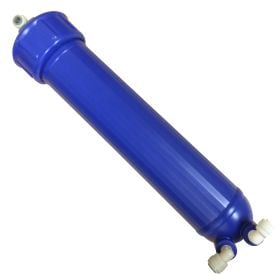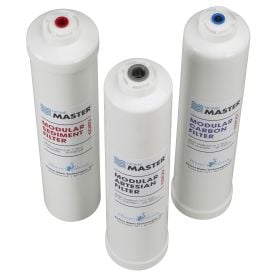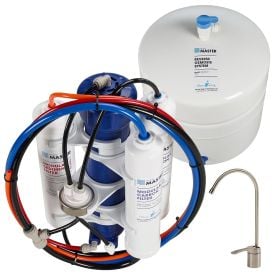
If you’re looking for a convenient way to improve the taste and safety of your home drinking water, a reverse osmosis system may be a wise investment. Reverse osmosis systems have gained greater popularity over the years, thanks to their ease of use, fill rate, and the healthy water that they produce.
But how does a reverse osmosis system work, exactly?
Check out our guide to learn everything you need to know about reverse osmosis, including the cost and benefits of ownership.
What Is a Reverse Osmosis System?
So what is a reverse osmosis system? This product is designed to improve the safety and health of drinking water by removing contaminants from your home’s water.
A reverse osmosis system can remove up to 99% of the large and small suspended particles that may be found in untreated or even treated water, and dissolved solids like salt, fluoride, metals, and more.
The process removes contaminants by using pressure to send water through a semipermeable membrane, which rejects virtually all contaminants and allows the pure water to flow to the other side. This pure water is called the permeate, while the leftover water is called the brine. For more information, check out - What contaminants can Home Master Reverse Osmosis remove?
How Does a Reverse Osmosis System Work?
There are several stages to the reverse osmosis process. As the name suggests, this system reverses the water’s natural osmotic process.
During the typical osmosis process, water travels through a membrane and becomes equally balanced on both sides. However, with reverse osmosis, the membrane under pressure is used to block contaminants carried in a water stream and create an unequal balance of fresh water on one side and brine on the other.
Here’s how it works:
- Water enters the system and travels to the prefiltering section, where carbon and/or sediment filter takes out particles like chlorine and sediment, which could foul, clog or damage the semipermeable membrane.
- Next, the water enters the membrane which removes virtually all contaminants, allowing the freshwater to flow through to the other side.
- The freshwater moves onto a storage tank, where it's pressurized and ready for household use.
- The reverse osmosis system keeps filtering water until the tank is full.
- When a homeowner turns on the faucet, the water passes through a postfilter for a final stage of filtering.
- As the water is used from the storage tank, the system begins filtering water again.
Benefits of a Reverse Osmosis System
There are many benefits to investing in a reverse osmosis system for your home. By removing harmful particles and metals, reverse osmosis water is healthier and safer for you to consume than unfiltered tap water. Here are just a few of the many reasons to drink water purified by a reverse osmosis system:
- Healthier water: The health benefits of reverse osmosis water are numerous. When contaminants are removed from drinking water, it may reduce the risks of high blood pressure and limit illness caused by accidental chlorine consumption from tap water.
- Tastes better: No one wants to have to guzzle down foul-tasting tap water. But unfortunately, even water that has been treated by the city can have a bad taste. Reverse osmosis leaves you with better-tasting water that enhances your beverages and meals.
- Fewer odors: Sometimes water that comes out of the tap has a bad odor that makes it unappealing to drink. Reverse osmosis also eliminates odors from your tap water, so you can always enjoy the freshest, best tasting (and smelling) drinks, soups, and pastas.
- Eco-friendly: Many people who don’t like the taste of their tap water opt for buying bottled water instead. All of that plastic waste is bad for the environment (and your wallet, too), and can contain chemicals and microplastics. Fortunately, reverse osmosis is a more eco-friendly choice, allowing you to minimize the need for buying bottled water.
- Convenient: No need to rush out to the store when you want fresh water to drink. Reverse osmosis delivers fresh water to your tap—without ever having to think about it. Installation and maintenance are easy, too, making reverse osmosis an all-around convenient choice.
How Much Does a Reverse Osmosis System Cost?
The total expense depends on the type of reverse osmosis system you buy and the lifespan of your system. Routine maintenance will ensure your system lasts as long as possible, which will reduce your overall cost of ownership.
An under-sink reverse osmosis system costs a few hundred dollars, depending on the size of the system, faucet choice, and other available features such as UV sterilization for well-water. Homeowners will also need to consider installation and maintenance costs, which vary depending on the type of system.
Improve Your Water with a Reverse Osmosis System Today
If you’re ready to enjoy the perks of a reverse osmosis system, head to Perfect Water today. We carry a wide range of the highest quality reverse osmosis systems, ensuring you always have the freshest, tastiest water to drink, cook with, or use for any other purpose in your home.
Shop our reverse osmosis systems today.






